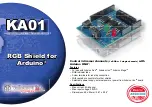
6.6.7 Warm-up
Mode transition may require the warm-up so that the oscillator provides stable oscillation.
In the mode transition from STOP to the NORMAL/SLOW or from SLEEP to NORMAL, the warm-up coun-
ter and the internal oscillator are activated automatically. And then the system clock output is started after
the elapse of warm-up time.
It is necessary to set a warm-up source clock in the CGOSCCR<WUPSEL2><WUPSEL1> and to set the
warm-up time in the CGOSCCR<WUODR[11:0]><WUODRL[1:0]> before executing the instruction to en-
ter the STOP/SLEEP mode.
In the transition from NORMAL to SLOW/SLEEP, the warm-up is required so that the external low-speed
oscillator to stabilize if the external low-speed oscillator is disabled. Enable the external low-speed oscillator
and then activate the warm-up by software.
In the transition from SLOW to NORMAL when the internal or external high-speed oscillator is disabled, en-
able the high-speed oscillator and then activate the warm-up.
In regard to warm-up time, please refer to "6.6.8 Clock Operations in Mode Transition".
Table 6-8 shows whether the warm-up setting of each mode transition is required or not.
Table 6-8 Warm-up setting in mode transition
Mode transition
Warm-up setting
NORMAL → IDLE
Not required
NORMAL → SLEEP
Not required(Note1)
NORMAL → SLOW
Not required(Note1)
NORMAL → STOP
Not required
IDLE → NORMAL
Not required
SLEEP → NORMAL
Auto-warm-up
SLEEP → SLOW
Not required
SLOW → NORMAL
Not required(Note2)
SLOW → SLEEP
Not required
SLOW → STOP
Not required
STOP → NORMAL
Auto-warm-up (Note 3)
STOP → SLOW
Auto-warm-up
Note 1: If the external low-speed oscillator is disabled, enable the low-speed oscillator and then activate the warm-up by
software.
Note 2: If the internal or external high-speed oscillator is disabled, enable the high-speed oscillator and then activate the
warm-up by software.
Note 3: When the STOP mode is released by a reset of RESET pin or POR, do not warm-up operation automatically.
The reset as same as a cold reset must be input.
TMPM3V6/M3V4
6. Clock/Mode control
6.6 Low Power Consumption Modes
Page 70
2019-02-06
Содержание TMPM3V4
Страница 1: ...32 Bit RISC Microcontroller TX03 Series TMPM3V6 M3V4 ...
Страница 2: ... 2019 Toshiba Electronic Devices Storage Corporation ...
Страница 7: ...Revision History Date Revision Comment 2019 02 06 1 First Release ...
Страница 8: ......
Страница 22: ...xiv ...
Страница 52: ...TMPM3V6 M3V4 3 Processor Core 3 6 Exclusive access Page 30 2019 02 06 ...
Страница 148: ...TMPM3V6 M3V4 7 Exceptions 7 6 Exception Interrupt Related Registers Page 126 2019 02 06 ...
Страница 178: ...TMPM3V6 M3V4 9 Input Output port 9 2 Block Diagrams of Ports Page 156 2019 02 06 ...
Страница 206: ...TMPM3V6 M3V4 10 16 bit Timer Event Counters TMRB 10 7 Applications using the Capture Function Page 184 2019 02 06 ...
Страница 232: ...TMPM3V6 M3V4 11 Universal Asynchronous Receiver Transmitter Circuit UART 11 4 Operation Description Page 210 2019 02 06 ...
Страница 354: ...TMPM3V6 M3V4 14 Synchronous Serial Port SSP 14 6 Frame Format Page 332 2019 02 06 ...
Страница 419: ...TMPM3V6 M3V4 Page 397 2019 02 06 ...
Страница 420: ...TMPM3V6 M3V4 16 Analog Digital Converter ADC 16 6 Timing chart of AD conversion Page 398 2019 02 06 ...
Страница 462: ...TMPM3V6 M3V4 21 Watchdog Timer WDT 21 5 Control register Page 440 2019 02 06 ...
Страница 510: ...TMPM3V6 M3V4 22 Flash Memory Operation 22 4 Programming in the User Boot Mode Page 488 2019 02 06 ...
Страница 538: ...TMPM3V6 M3V4 25 Electrical Characteristics 25 7 Recommended Oscillation Circuit Page 516 2019 02 06 ...
Страница 541: ...26 3 TMPM3V4FWUG TMPM3V4FSUG Type LQFP64 P 1010 0 50E LPHQVLRQV TMPM3V6 M3V4 Page 519 2019 02 06 ...
Страница 544: ......
















































